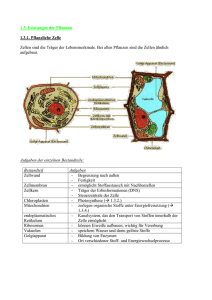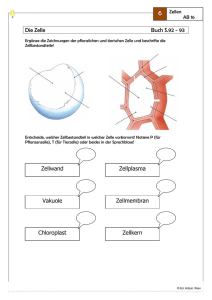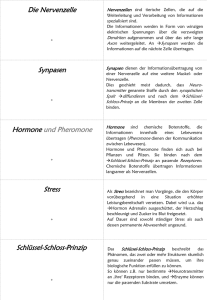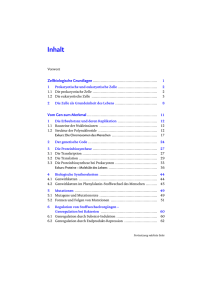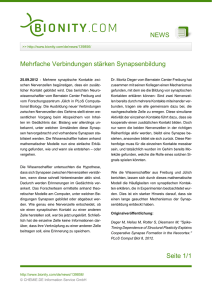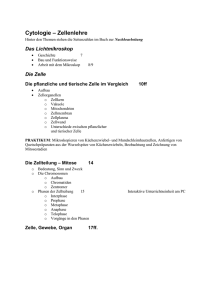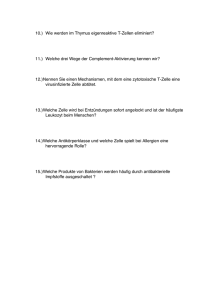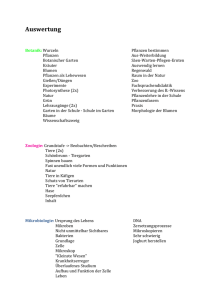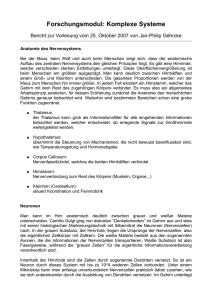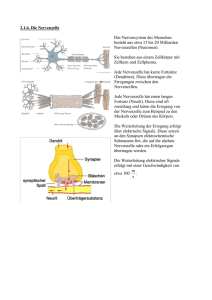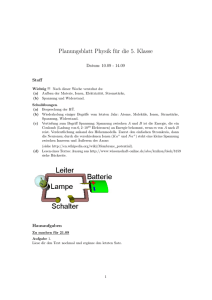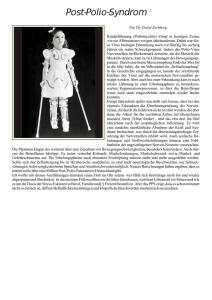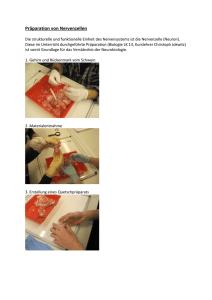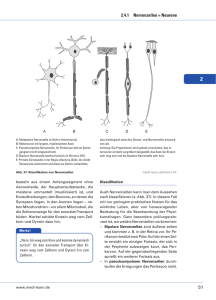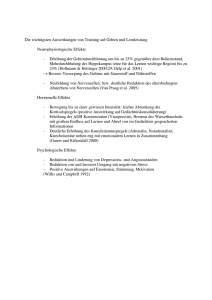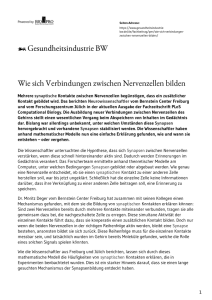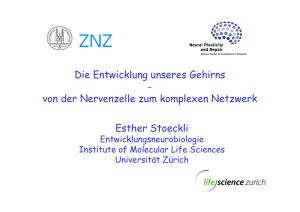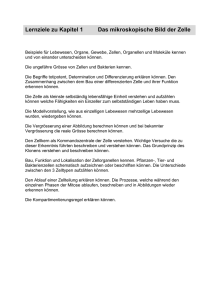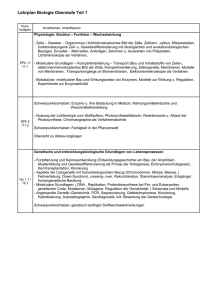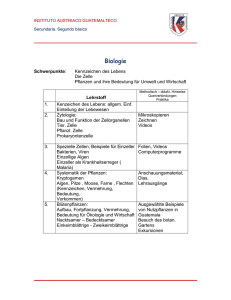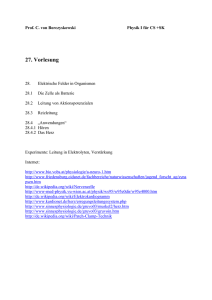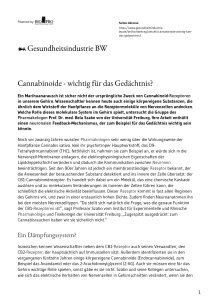Inhalt - STARK Verlag
Werbung
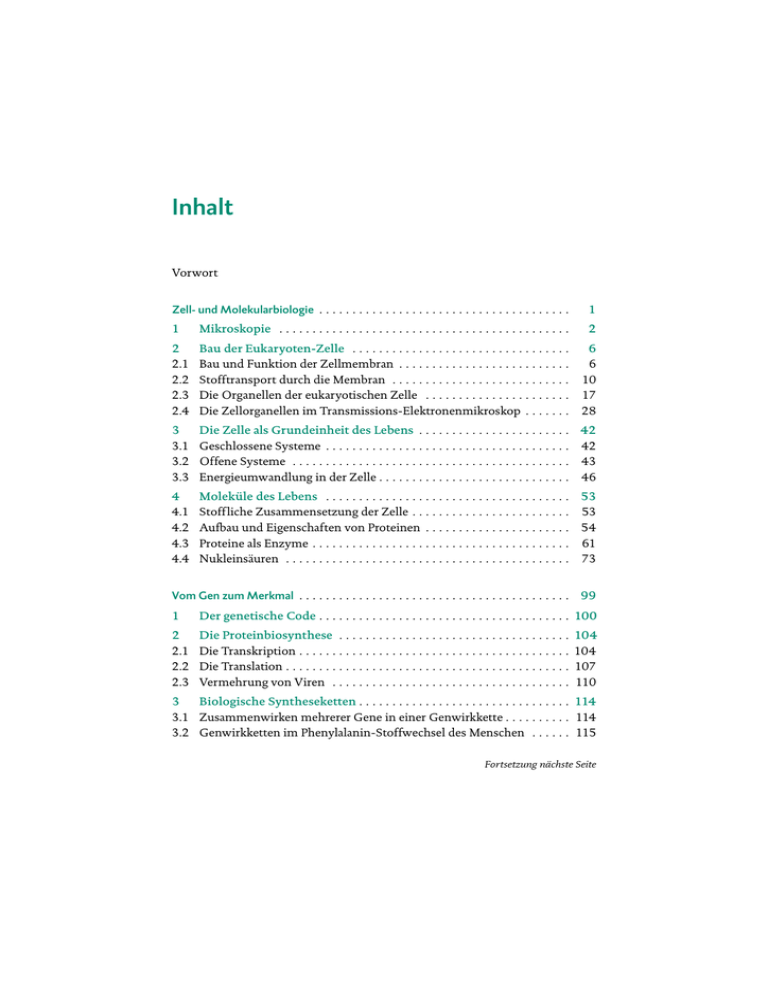
Inhalt Vorwort Zell- und Molekularbiologie . . . . . . . . . . . . . . . . . . . . . . . . . . . . . . . . . . . . . . 1 1 Mikroskopie . . . . . . . . . . . . . . . . . . . . . . . . . . . . . . . . . . . . . . . . . . . . 2 2 2.1 2.2 2.3 2.4 Bau der Eukaryoten-Zelle . . . . . . . . . . . . . . . . . . . . . . . . . . Bau und Funktion der Zellmembran . . . . . . . . . . . . . . . . . . . Stofftransport durch die Membran . . . . . . . . . . . . . . . . . . . . Die Organellen der eukaryotischen Zelle . . . . . . . . . . . . . . . Die Zellorganellen im Transmissions-Elektronenmikroskop . . . . . . . . . . . . . . . . . . . . . . . . . . . . . . . . . . . 3 3.1 3.2 3.3 Die Zelle als Grundeinheit des Lebens Geschlossene Systeme . . . . . . . . . . . . . . Offene Systeme . . . . . . . . . . . . . . . . . . . Energieumwandlung in der Zelle . . . . . . . . . . . . . . . . . . . . . . . . . . . . . . . . . . . . . . . . . . . . . . . . . . . . . . . . . . . . . . . . . . . . . . . . . . . . . . . . . . . . . . . . . . . . . . . 42 . 42 . 43 . 46 4 4.1 4.2 4.3 4.4 Moleküle des Lebens . . . . . . . . . . . . . . . Stoffliche Zusammensetzung der Zelle . . Aufbau und Eigenschaften von Proteinen Proteine als Enzyme . . . . . . . . . . . . . . . . . Nukleinsäuren . . . . . . . . . . . . . . . . . . . . . . . . . . . . . . . . . . . . . . . . . . . . . . . . . . . . . . . . . . . . . . . . . . . . . . . . . . . . . . . . . . . . . . . . . . . . . . . . . . . . . . . . . . . . . . . . . . . . . . . . . . . . . . . 53 . 53 . 54 . 61 . 73 6 6 10 17 28 Vom Gen zum Merkmal . . . . . . . . . . . . . . . . . . . . . . . . . . . . . . . . . . . . . . . . . 99 1 Der genetische Code . . . . . . . . . . . . . . . . . . . . . . . . . . . . . . . . . . . . . . 100 2 2.1 2.2 2.3 Die Proteinbiosynthese Die Transkription . . . . . . Die Translation . . . . . . . . Vermehrung von Viren . . . . . . . . . . . . . . . . . . . . . . . . . . . . . . . . . . . . . . . . . . . . . . . . . . . . . . . . . . . . . . . . . . . . . . . . . . . . . . . . . . . . . . . . . . . . . . . . . . . . . . . . . . . . . . . . . . . . . . . . . . . . . . . . . . . . . . . . . . . . . 104 104 107 110 3 Biologische Syntheseketten . . . . . . . . . . . . . . . . . . . . . . . . . . . . . . . . 114 3.1 Zusammenwirken mehrerer Gene in einer Genwirkkette . . . . . . . . . . 114 3.2 Genwirkketten im Phenylalanin-Stoffwechsel des Menschen . . . . . . 115 Fortsetzung nächste Seite 4 4.1 4.2 4.3 Mutationen . . . . . . . . . . . . . . . . . . . . Formen und Folgen von Mutationen . Mutagene und Mutationsrate . . . . . . . Entstehung von Krebs . . . . . . . . . . . . . . . . . . . . . . . . . . . . . . . . . . . . . . . . . . . . . . . . . . . . . . . . . . . . . . . . . . . . . . . . . . . . . . . . . . . . . . . . . . . . . . . . . . . . . . . . . . . . . . . . 119 119 122 124 5 Regulation von Stoffwechselvorgängen durch die Kontrolle der Transkription . . . . . . . . . . . . . . . . . . . . . . . 128 5.1 Genregulation bei Bakterien . . . . . . . . . . . . . . . . . . . . . . . . . . . . . . . . 128 5.2 Differenzielle Genaktivierung bei Eukaryoten . . . . . . . . . . . . . . . . . . 131 6 Zelldifferenzierung, Bildung von Geweben und Organen . . . . . . . 140 6.1 Dauergewebe und Bildungsgewebe . . . . . . . . . . . . . . . . . . . . . . . . . . . 140 6.2 Überblick über verschiedene Zelltypen . . . . . . . . . . . . . . . . . . . . . . . . 142 Informationsverarbeitung im Nervensystem . . . . . . . . . . . . . . . . . . . . . . . . . . 145 1 1.1 1.2 1.3 1.4 1.5 Bau und Funktion der Nervenzelle . . Bau der Nervenzelle und der Nerven . . Entstehung des Ruhepotenzials . . . . . . Entstehung des Aktionspotenzials . . . Weiterleitung von Aktionspotenzialen Erregungsleitung an der Synapse . . . . . . . . . . . . . . . . . . . . . . . . . . . . . . . . . . . . . . . . . . . . . . . . . . . . . . . . . . . . . . . . . . . . . . . . . . . . . . . . . . . . . . . . . . . . . . . . . . . . . . . . . . . . . . . . . . . . . . . . . . . . . . . . . . . . . . . . . . . . . . . . . . . . . 146 146 149 154 161 164 Codierung und Verarbeitung der Informationen an Nervenzellen . . . . . . . . . . . . . . . . . . . . . . . . . . . . . . . . . . . . . 2.1 Codierung der Information an Axonen . . . . . . . . . . . . . . . . . . . . 2.2 Verschaltung von Nervenzellen und Verrechnung der Erregung 2.3 Verschaltung von Nervenzellen im Rückenmark . . . . . . . . . . . . . . . . . . . . . . . . . . . . 181 181 184 193 3 3.1 3.2 3.3 3.4 . . . . . . . . . . . . . . . . . . . . 205 205 207 208 220 2 Informationsverarbeitung im Gehirn . . . . . . . . . . . . Aufbau und Leistungen des menschlichen Gehirns . . Aufbau und Leistungen des menschlichen Großhirns Verarbeitung visueller Informationen . . . . . . . . . . . . . Sprachsteuerung durch Felder des Großhirns . . . . . . . . . . . . . . . . . . . . . . . . . . . . . . . . . . . . . . . . . . . . . . . Kommunikation im Immunsystem – Immunreaktionen . . . . . . . . . . . . . . . . . . 231 1 Unspezifische Immunreaktionen . . . . . . . . . . . . . . . . . . . . . . . . . . . 232 2 2.1 2.2 2.3 2.4 2.5 Spezifische Immunreaktionen . . . . . . . . . . . . . . . Spezifische Erkennung körperfremder Substanzen . Antikörper . . . . . . . . . . . . . . . . . . . . . . . . . . . . . . . . Ablauf der spezifischen Immunreaktion . . . . . . . . . Aktive und passive Immunisierung . . . . . . . . . . . . . Blutgruppen und Bluttransfusionen . . . . . . . . . . . . . . . . . . . . . . . . . . . . . . . . . . . . . . . . . . . . . . . . . . . . . . . . . . . . . . . . . . . . . . . . . . . . . . . . . . . . . . . . . . . . . . . . 233 233 234 237 243 244 3 3.1 3.2 3.3 3.4 3.5 3.6 Störungen des Immunsystems . . . . . . . . . . Krebs . . . . . . . . . . . . . . . . . . . . . . . . . . . . . . . . AIDS . . . . . . . . . . . . . . . . . . . . . . . . . . . . . . . . Autoimmunerkrankungen . . . . . . . . . . . . . . . Transplantation von Geweben und Organen Allergien . . . . . . . . . . . . . . . . . . . . . . . . . . . . . Immunologische Nachweisverfahren . . . . . . . . . . . . . . . . . . . . . . . . . . . . . . . . . . . . . . . . . . . . . . . . . . . . . . . . . . . . . . . . . . . . . . . . . . . . . . . . . . . . . . . . . . . . . . . . . . . . . . . . 246 246 246 248 249 249 251 . . . . . . . . . . . . . . . . . . . . . . . . . . . . . . . . . . . Lösungen . . . . . . . . . . . . . . . . . . . . . . . . . . . . . . . . . . . . . . . . . . . . . . . . . . . . 261 Stichwortverzeichnis . . . . . . . . . . . . . . . . . . . . . . . . . . . . . . . . . . . . . . . . . . 337 Quellenverzeichnis . . . . . . . . . . . . . . . . . . . . . . . . . . . . . . . . . . . . . . . . . . . 349 Autor: Dr. Werner Bils Hinweis: Die in diesem Buch angegebenen Verweise auf weitere relevante Textstellen sowie das Stichwortverzeichnis beziehen sich gleichzeitig auf den Band Biologie 2, Verlags-Nr. 847028. Die Fundstellen werden daher durch die vor der Seitenzahl in Klammern aufgeführten Ziffern 1 (für Biologie 1) bzw. 2 (für Biologie 2) gekennzeichnet.
